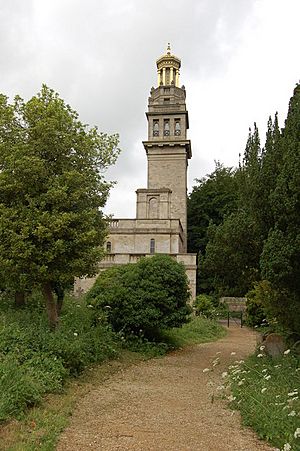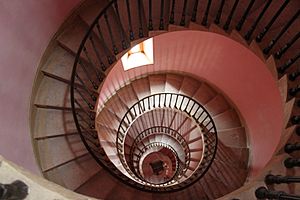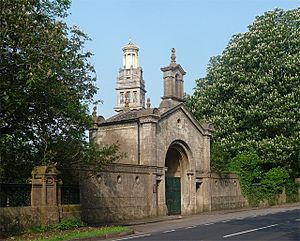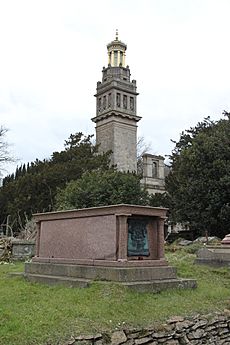Beckford's Tower facts for kids
Quick facts for kids Beckford's Tower |
|
|---|---|
| Lansdown Tower | |

Beckford's Tower with part of the surrounding cemetery
|
|
| Location | Lansdown Hill, Bath, Somerset, England |
| Height | 154 feet (47 m) |
| Built | 1827 |
| Built for | William Thomas Beckford |
| Restored | 1972 (house), 1997-2000 (tower) |
| Restored by | J. Owen Williams (house), Caroe & Partners, Mann Williams Structural Engineers (tower) |
| Architect | Henry Goodridge |
| Owner | The Beckford Tower Trust (Bath Preservation Trust) |
|
Listed Building – Grade I
|
|
| Official name: Beckford's Tower, with attached wall and railings | |
| Designated | 11 August 1972 |
| Reference no. | 1394133 |
| Official name: Lansdown Cemetery and Beckford's Tower | |
| Designated | 30 April 1987 |
| Reference no. | 1000563 |
| Lua error in Module:Location_map at line 420: attempt to index field 'wikibase' (a nil value). | |
Beckford's Tower, also known as Lansdown Tower, is a tall, interesting building near Bath, England. It was built in a classical style on Lansdown Hill. The tower and its railings are very important, listed as a Grade I building. The nearby Lansdown Cemetery is also special, listed as a Grade II historic park.
The tower was built for William Thomas Beckford, who was a rich writer and art collector. Henry Goodridge designed it, and it was finished in 1827. Beckford used the tower as a quiet place to read and keep his books. The top part, called a belvedere, offered amazing views of the countryside. The building at the bottom of the tower had fancy rooms and another library. Beckford also created beautiful gardens, known as Beckford's Ride, that stretched from his home to the tower.
After Beckford passed away in 1844, the tower and land were given to the local church parish. A burial ground was made, and one of the tower's rooms became a chapel. In 1931, a fire damaged the house part of the tower. People helped raise money to fix it. The cemetery closed in 1992, and the Bath Preservation Trust bought the site in 1993. They worked hard to restore the tower. Today, it is a museum where you can see furniture and art from Beckford's life.
William Beckford became wealthy from plantations and enslaved people. Later, he received money from the government when slavery was abolished. The museum at Beckford's Tower explains how his wealth allowed him to build and collect so many things.
Contents
History of Beckford's Tower

Beckford's Tower was finished in 1827. It was built for William Beckford, a very rich man who lived in Lansdown, overlooking the city of Bath. Henry Goodridge, an architect from Bath, designed it. Beckford was a famous writer, art collector, and travel writer. At one point, he was thought to be one of the richest people in England who wasn't a noble.
In 1822, Beckford sold his large estate, Fonthill Abbey, and much of his art. He then moved to Bath. He bought several houses in Lansdown Crescent and connected them.
The tower was at the end of beautiful gardens called Beckford's Ride. These gardens stretched from his house all the way to the tower on top of Lansdown Hill. Beckford used the tower as a library and a quiet escape. He often rode up to the tower to check on his gardens. From the very top, he could even see ships in the Bristol Channel with a telescope!
Beckford filled his houses and the tower with his favorite art, books, and furniture. One long, narrow room in the tower was a special prayer room. It had paintings of religious scenes and a marble statue of the Virgin and Child. In 1841, some items from the tower were sold, and the rooms were refurnished.
Later Owners and Restorations
After William Beckford died in 1844, his daughter, Susan Euphemia Beckford, moved many of his books and treasures. The tower was then put up for sale but didn't sell. In 1847, a local pub owner bought it and turned it into a beer garden.
Later, Beckford's daughter bought the tower back. In 1848, she gave the land around it to the Walcot parish to become a cemetery. This allowed Beckford's body to be moved and reburied near the tower, as he had wished. His tomb is a large, pink stone coffin with bronze decorations. It stands on a small hill in the cemetery. One of the tower's rooms was turned into a chapel for the cemetery.
Over the years, the tower needed repairs. In 1931, a fire badly damaged the house part of the tower, which was then a chapel. Luckily, firefighters stopped the fire from reaching the wooden stairs inside the tower. People raised money to fix the damage. By 1954, the stairs were unsafe, and more money was needed for repairs.
Bath Preservation Trust's Role
Since 1993, the Bath Preservation Trust has owned Beckford's Tower. They manage it through The Beckford Tower Trust, which is a charity. The tower was restored in 1995 and opened to the public in 2001. You can even rent the ground floor of the tower for a holiday!
In 2019, the tower was added to the Heritage at Risk Register because water was getting inside. The Bath Preservation Trust started a big project to raise £3 million to restore the tower and its surroundings. They received a large grant from the National Lottery Heritage Fund in December 2019. The trust bought the site in 2021. In September 2022, they received another £3 million grant, reaching their fundraising goal. The tower and museum reopened in June 2024 after all the work was completed.
Tower Architecture
The tower stands about 154 feet (47 meters) tall and has three main parts. The bottom part is square with small windows. The middle part has tall, plain columns and arched openings.
The very top of the tower has a beautiful golden lantern, also called a belvedere. This top section was inspired by ancient temples. It has eight columns supporting a metal roof. Inside, a stone spiral staircase leads up to 53 wooden steps. These steps take you to the very top, where you can enjoy the views. There was once a furnace at the base of the tower that sent warm air up through the building.
Below the tower is an Italianate-style building. This building had a fancy drawing room and a small entrance area. It also had a kitchen and offices. The floor above held another drawing room, a sanctuary, and a library.
Cemetery and Gardens
The gardens that connected Beckford's house to the tower were called Beckford's Ride. They included different types of gardens, like a terraced Italian garden and a forest of pine trees. There was also a special tunnel under a path that led into the tower garden. Beckford planted unique trees and flowers to attract birds like nightingales and thrushes. An old quarry was turned into a walled garden for growing fruits and vegetables.
The entrance gate to the grounds was designed in a Byzantine style. Bronze railings were added later. These railings had once surrounded Beckford's first tomb. They were removed during World War II but were put back in 2000. Stone walls, about 2 meters (6.5 feet) high, surrounded the gardens.
After Beckford's death, part of the grounds became Lansdown Cemetery in 1848. Burial plots were arranged in neat rows. The cemetery was made larger in 1947 and again in 1961. Besides Beckford's tomb, many other important people from Bath are buried there. These include Henry Goodridge, the architect of the tower, and members of the Holburne family, who started the Holburne Museum.
The cemetery closed in 1992. Since then, the local council and a group called the Lansdown Cemetery Trust have taken care of it.
Beckford's Tower Museum
The tower is now home to a museum. It shows furniture that was originally made for the tower. You can also see paintings, prints, and other items that tell the story of William Beckford's life. He was a writer, a collector, and someone who supported artists. Visitors can climb the spiral staircase to the restored belvedere at the top. From there, you get amazing views of the countryside all around.
Other Interesting Places Nearby
- Sham Castle, another interesting building overlooking Bath
- Browne's Folly, another tower overlooking Bath





